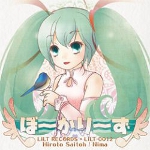Vocalize
 |
Album Title: Vocalize |
| Record Label: LILT Records |
|
| Catalog No.: LILT-0012 |
|
| Release Date: December 30, 2009 |
|
| Purchase: Buy at Sweep Records |
Overview
Released at the end of 2009, Vocalize features a variety of musical styles. There is a catch though, especially for those who dislike Japanese singing. The catch, of course, is that all singing is done by the popular Miku Hatsune vocaloid program. According to Hiroto Saitoh, he composed music he wanted to compose without taking into considering the vocaloid. So, how does the music, with and without Miku Hatsune, turn out?
Body
The album opens up with my favorite song from the album, “Lycoris Radiata.” It is a fantastic theme with a very Castlevania-like sound. Excellent organ accompaniment, upbeat piano accompaniment, choral accents, some rocking electric guitar work, and of course, the intense drum pad, all really make this a stunning musical composition with an extremely strong melody. As for the vocals, it’s one of the few songs in which I think they really add to the piece. Most might find the vocals a bit off-putting though.
“Reflection” is a reprise of the theme of the same name from Retrospective Blue. “Reflection” opens up with some spoken word and it’s clear from the beginning that this is going to be a heavily jazz based piece. The original vocalist, Kiyomi, is obviously replaced by Miku Hatsune. It’s an entertaining vocal piece with an exciting rhythm and some beautiful jazz piano accompaniment. There are also some stunning jazz flute passages and a bit of a hip-hop influence at times, although that’s mainly in the form of some scratching techniques thrown in every once in a while. There is also an instrumental version of this theme.
The next theme, “Midnight Journey,” is an interesting fusion of chiptune and jazz elements. It’s an extremely upbeat theme with a fantastic melody and some dramatic orchestral bridges, but the vocaloid performance is definitely pushes the saccharine boundary. For those who aren’t fans of Japanese female vocals, you’ll definitely find the singing in this piece hard to deal with. You will be fortunate to learn there is an instrumental version of this theme that you will most likely find much more enjoyable. “pole pole,” based on a piece by Chopin, continues with the retro jazz vibe. I really like the combination of jazz piano and chiptune melody. As for the vocals, they are a bit more tolerable than in “Midnight Journey.” Thankfully the music is quite enjoyable.
“Tender…” is another fantastic musical theme with a J-pop/rock vibe. It’s an upbeat theme where I think that the vocals really help add to the overall experience. I love how playful the piano accompaniment is and the electric guitar solo really adds a new dimension to the entire piece. For a name like “Tender…”, it has its tender moments, but for the most part, it’s definitely an exhilarating experience. “Night Bird Addiction” is definitely one of the most interesting themes on here. A combination of funk, jazz, and espionage oriented music makes for an entertaining listen. I also don’t mind Miku Hatsune’s vocals on this one. There are sections where they are a bit on the shrill side, but for the most part, they are more subdued than most people use them. The combination of DJ scratching, hip-hop influence, espionage music, and funk really make for an exquisitely complex soundscape, but one that really is quite successful. For those who aren’t fans of Miku Hatsune, there is an instrumental version as well.
“Winter to Lead to the World’s End” is a lounge jazz oriented theme that features an exquisite soundscape. The acoustic guitar, violin, and jazz instrumentation really create a beautiful and poignant atmosphere. The melody is pretty enjoyable as well. As for the vocals, they are more subdued in this piece as well, but there isn’t an instrumental version of this theme for those who like the music but can’t stand the vocals. “Lunatic Fanatic” is a technopop theme similar to what you might hear on Technictix. It’s an extremely bubbly piece of music, but at the same time, I find the vocals to be a hindrance to my enjoyment of the theme. The music behind the vocals though is superb, with a bit of a jazz and spacey flair. Fortunately, there is an instrumental version of this theme.
Lastly, “Prayer’s Song to Snowflakes” closes off the album and also features an instrumental version. The music behind this theme is also quite exquisite. Mainly Celtic in nature, it features a very warm and inviting atmosphere. The Celtic flute is truly the highlight in the accompaniment and the overall vocal performance manages to stay neutral in terms of me liking it or not. Even so, the instrumental version is probably the way to go as you can enjoy the lush Celtic soundscape without interruption.
Summary
In the end, I find this to be the weakest of Saitoh’s albums, but mainly because the vocaloid program, Miku Hatsune, is definitely a select taste. At times, she did add to the overall experience, but for the most part, she was a neutral or negative influence. Fortunately, there are instrumental versions of these themes, mainly for the ones to which I thought impacted the themes in a negative way, so there is that going for it. Musically speaking, it is the most diverse of Saitoh’s albums and all the music is quite enjoyable.
Do you agree with the review and score? Let us know in the comments below!
3.5
Posted on August 1, 2012 by Don Kotowski. Last modified on August 1, 2012.














